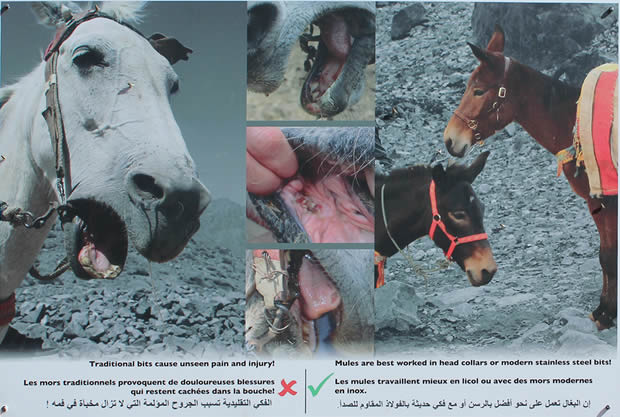
Horseytalk.net Special Interview
Glen Cousquer
DEVELOPING AND PROMOTING ALTERNATIVES TO THE MEDIEVAL TRADITIONAL BIT
Says Glen Cousquer, a veterinary surgeon and International Mountain Leader who has been collaborating with The Donkey Sanctuary over the last five years to improve the welfare of expedition mules in Morocco and worldwide.
The traditional bit is a medieval instrument that has, for far too long, allowed man to control and dominate the mule. It is widely used across Morocco, causing pain, suffering and great discomfort to the country's mules.
The bit is often used to drive on mules whose tired, aging, arthritic bodies are no longer able to work in the mountains and it is in these older mules that the worst injuries are seen - horrendous injuries to the sensitive tissues of a mule's mouth.
Most, if not all, of these injuries go unseen and unnoticed; unnoticed that is by the owners and communities for whom these mules labour.
The mule, however, is aware of them every second of every day. They stand there, with blood in their mouths, struggling to eat, with pain etched across their faces, their owners oblivious to their suffering. This terrible problem has gone unnoticed for far too long largely due to a lack of awareness of the suffering caused.
It is therefore fantastic to be able to report on the remarkable progress seen over the past few weeks in our struggle to tackle this issue. Working with partners within and across the local community, our work has involved a number of key components, including:
- An intensive educational programme to raise awareness of the serious welfare problems associated with these bits – both within the local community and across the mountain tourism industry.
- The design, testing and development of alternative systems.
- The destruction of traditional bits.
- Training in mule handling and riding.
EDUCATIONAL INITIATIVES
A number of signs have been designed and erected at key points within the community, such as the one on top of the mule water trough beside the main path, heading up the valley. This sign is passed by every visitor heading into the National Park and is viewed by the muleteers on a daily basis. As the muleteers take bits out of the mouths of their mules to allow them to drink, they challenged with the question: "Are you working your mule in an acceptable fashion?"
Since my last blog about the mountain-tourism agencies workshop, we have undertaken further education and training for local muleteers. We have explained why these more progressive agencies will not be permitting mules to work in traditional bits; and we have provided further training on the alternatives. Viable alternative are essential if this initiative is to be successful.
TRAINING IN MULE HANDLING AND RIDING
We have introduced head collars and have worked with our partners, and in particular Ellen Cochrane of Gaia Horsemanship, to help provide training in bitless riding and in mule training and handling. Muleteers from the local community have benefited from this training and this has helped us better identify and understand their needs as well as those of their mules. In particular we have focussed on developing an understanding of how mules can be turned, slowed and stopped both when being led and when ridden. Local Muleteer associations are also being set up to support and further this work and this will be the subject of a future blog.
DESIGN, TESTING AND PRODUCTION OF A BITLESS BRIDLE
The introduction of bitless head collars proved popular, with over a hundred mules now working in them. Production of these head collars by the communities themselves was the next step. With this in mind, a bitless bridle has been designed and tested within the community. The muleteers involved in its development feel that this might actually provide superior control of their mules and are asking for it be made available to all.
On a technical level, the bitless bridle allows the mule to be used both as a pack animal and as a saddle mule. In this sense it is superior to the other alternatives available locally, including head collars and a stainless-steel curb bit. While the curb bit does not work well with the existing local bridle as it drags across the mouth (particularly when leading or turning), by contrast the bitless bridle's noseband slots directly into the local bridle and lends itself to use both as a head collar and bridle. It is therefore suitable for packing and riding. Perhaps most importantly, the community now has three viable alternatives that are all superior to the traditional bit.
The bitless bridle is now being manufactured in the village by the women of the Association Tamghartenoudrare. Very appropriately, on International Women's day, they released a video that explained the welfare issues surrounding the use of the traditional bit and the solution they have developed and are now manufacturing. This video has already given rise to enquiries from prospective buyers from across Morocco.
DESTRUCTION OF THE TRADITIONAL BITS
This onslaught against the traditional bit has had such an impact that the local community are now surrendering their traditional bits in droves. Indeed, in the past three weeks, some sixty traditional bits have been surrendered. These have all been destroyed in public and will, it is hoped, be used to construct a specially commissioned sculpture of a mule.
This collaborative community project has drawn on many different partners and their contributions are all very much appreciated. We would particularly like to thank Mike McHugo, Hajj Morris and the staff at the Kasbah du Toubkal, as well as Ellen Cochrane, Pat Colip, Kathryn Kelly, Melisa Johnson, Hamish Jack for his work on the bitting signs, the ladies of the Association Tamgharteneoudrare and to Ali and all the mules and muleteers who have volunteered so much of their time and worked with us.



